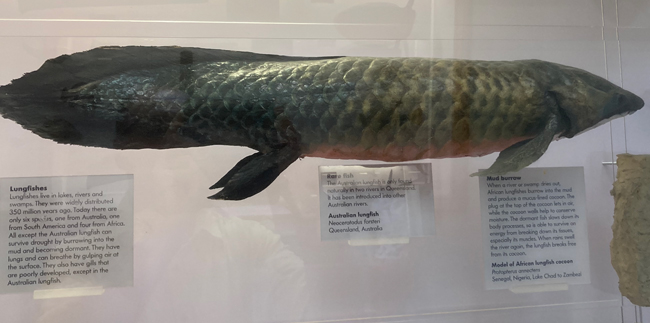Yesterday, Everything Dinosaur team members posted up an article that provided information on the evolutionary history of burrowing vertebrates. The first vertebrates to dig burrows were probably lungfish. These animals were similar to extant lungfish, animals such as Neoceratodus forsteri, the Australian lungfish. This taxon is also referred to as the Queensland lungfish.
Ironically, it is thought that this species of lungfish does not enter a dormant state (aestivation), by producing a mucous cocoon and burying itself in mud. Neoceratodus forsteri inhabits slow-moving rivers and reservoirs, primarily in south-eastern Queensland. In contrast, the African genus Protopterus does dig burrows. Protopterus is distantly related to the Australian lungfish. During the dry season when lakes tend to dry up, this fish excavates a burrow and buries itself in the mud. It enters a state of dormancy (aestivation), enabling it to survive whilst it waits for the water to return. During aestivation Protopterus is able to reduce its metabolism to 1/60th of its active state.

Picture credit: Everything Dinosaur
A team of researchers, including scientists from the Museum für Naturkunde Berlin examined the origins and early evolution of vertebrate burrowing behaviour. Their paper was published in Earth-Science Reviews.
To read Everything Dinosaur’s article about this new research: Digging into the History of Burrowing Vertebrates.
The Scientific Paper
The scientific paper comprises a short overview of convergent morphological and behavioural adaptations seen in modern fossorial taxa. The researchers also document the diversity of extant vertebrate burrows. In addition, the team reviews the fossil record of inferred vertebrate burrows and fossorial vertebrates from the Devonian to the Triassic. Results highlight a probable Devonian earliest occurrence of fossoriality in continental vertebrates (Dipnoi – lungfishes).
The earliest lungfish taxa were mostly marine animals. However, after the Carboniferous, lung fish fossils are confined to deposits laid down in freshwater environments.
The Australian lungfish specimen at the London Natural History Museum is displayed next to a model of a Protopterus burrow. This can confuse visitors, it was stated earlier in this article that not all lungfish exhibit this burrowing behaviour.
The award-winning Everything Dinosaur website: Everything Dinosaur.






Leave A Comment